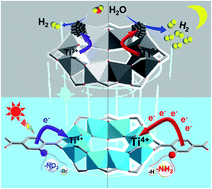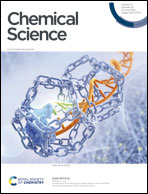Linker engineering in metal–organic frameworks for dark photocatalysis†
Abstract
Dark reactions featuring continuous activity under light off conditions play a critical role in natural photosynthesis. However, most artificial photocatalysts are inactive upon the removal of the light source, and the artificial photocatalysts with dark photocatalysis abilities have been rarely explored. Herein, we report a Ti-based metal–organic framework (MOF), MIL-125, exhibiting the capability of dark photocatalytic hydrogen production. Remarkably, the introduction of different functional groups onto the linkers enables distinctly different activities of the resulting MOFs (MIL-125-X, X = NH2, NO2, Br). Dynamic and thermodynamic investigations indicate that the production and lifetime of the Ti3+ intermediate are the key factors, due to the electron-donating/-withdrawing effect of the functional groups. As far as we know, this is the first report on dark photocatalysis over MOFs, providing new insights into the storage of irradiation energy and demonstrating their great potential in dark photocatalysis due to the great MOF diversity.

- This article is part of the themed collections: Most popular 2022 catalysis articles and Metal organic frameworks and porous polymers


 Please wait while we load your content...
Please wait while we load your content...